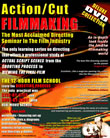|
|
FEATURES
- Film
Editing
|
 |
|
|
|
|
|
|
|
|
| Sponsors |

|
|
|
 |
|
 |

|
|
Film Editing - page 5
|

|
|
The editor has the most comprehensive view of the actor's film performance. Every take is viewed, then see again and again as the editor makes creative decisions. Even the looping sessions, where actors have their dialogue re-recorded to match the picture, can demonstrate certain unique performance abilities.
Continuity is also a major consideration. Being technically accurate can be as important as being emotional accurate. Actors often think of the editor as the enemy, someone who is likely to leave their best performance or their entire performance on the cutting room floor.
The actor has to realize that editors are not sitting there passing
judgment on what they like and dislike. Editors are their best friends, trying to do the best from them. Unfortunately, they can't present their best work if it's compromised by technical incompetence. Editors are an extremely respected group of individuals, but if they are not able to cut it, they will have to compromise, and it will be at their expense.
Editors are often asked to compensate for an actor's performance problems. "You can save a bad performance by pacing a part of his dialogue on his back or on the
cutaways to other actors. Since editors see every mistake and are often frustrated with the actor's work, it's always interesting when they are impressed by a performance," states editor Bill Reynolds.
Editors often say that they are the "first audience" to see a film. The audience remains uppermost in mind as they go about their task of trying to tell the story in the clearest, most cohesive and visual manner. Perhaps the single greatest concern among today's editors is that they are required to accomplish this at an increasingly rapid rate.
|
|

|

|
|
The editor needs to have a rigorous discipline, to know why you're doing the picture; it's about sensitivity and
selectivity
|
|

|
|
|
The editor must assemble the film in ten to fourteen days after the production wraps. So much film, so little time. During the next eight or ten weeks, the director and editor work closely together to shape the film onto its next incarnation, the director's cut. How close this version is to what is released will depend on the degree of the director's clout with the studio as well as other contractual obligations.
At every stage of the editing process, it is the editor's responsibility to help make the story clear to the audience. This is accomplished through the use of a visual language. Since the best editing often goes unnoticed by the audience, the editor's manipulation of images is vital but somewhat invisible.
Timing is a big part of it; it has to do with musicality. The timing of a piece of music, the timing of a language, how it flows, how it goes from one moment to the next. The speech patterns of an actor have their own rhythm and musicality.
The editor needs to have a rigorous discipline, to know why you're doing the picture; it's about sensitivity and selectivity. Since the visual language of editing is mostly invisible, is it possible to ascertain the editor's contribution when seeing the final product? Sometimes the genre or subject matter of the film will help determine the appropriate editing style.
Finally, there are those scenes that the editor must "save" if the film is going to work at all. These often result from problems encountered during filming or decisions made in postproduction.
|
|

|
|
|
|
|
|
|
|

|
|
|

|

|
|
top of page
|
Home
Page |
Contests
| Indies
| Features
| News
| Resource
Links
| Advertise
With Us |
Important
disclaimer
Copyright ©
1999-2011 by FilmMakers.com. All rights reserved.
FilmMakers.com
is a division of Media Pro Tech Inc.
|

|
|
|